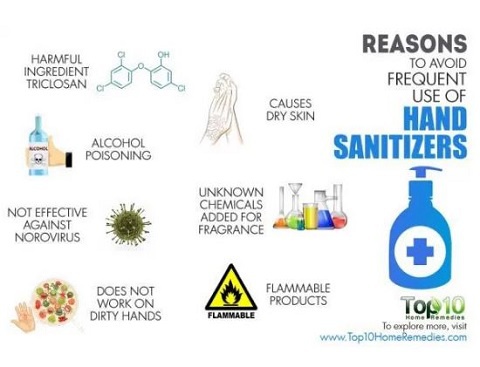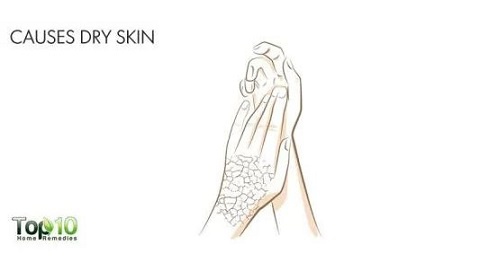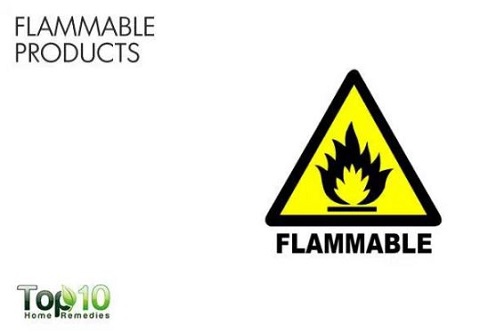One hygiene product that has gained huge popularity in recent times is hand sanitizers.
As people are becoming aware of the importance of proper hand-washing in reducing harmful germ transmission, several hand sanitizer products have flourished in the market.
People are often seen rubbing a dab of sanitizer over their hands to eliminate any germs that may be clinging to their skin. Hand sanitizers are mostly used when there is no access to soap and water or not enough time to wash thoroughly.
But with hand sanitizers, there are two questions that strike the mind. Can a hand sanitizer serve as a suitable alternative to hand washing?
Can it eliminate illness-causing germs in situations where using soap and water is inconvenient?
While hand sanitizers do kill germs, it’s important to limit your use of them.
Excess use of this hygiene product has certain drawbacks that can cause other health problems.

Here are several reasons to avoid frequent use of hand sanitizers.
1. Harmful Ingredient Triclosan
In most commercial hand sanitizers, one common chemical used for its antibacterial properties is triclosan. But it may do much more harm than good. This chemical can contribute to making bacteria resistant to antibiotics.
According to a 2006 study published in the journal Microbial Drug Resistance, widespread use of triclosan may pose a potential public health risk of concomitant resistance to clinically important antimicrobials.
Another 2014 study published in Frontiers in Microbiology also notes that this chemical is associated with multidrug resistance.
A 2012 study published in the Proceedings of the National Academy of Sciences notes that triclosan, a high-production-volume chemical used as a bactericide in personal care products, is a priority pollutant of growing concern to human and environmental health.
The study found that the chemical can weaken cardiac and skeletal muscle contractility in a manner that may negatively impact muscle health, especially in susceptible populations.
2. Alcohol Poisoning
Even if hand sanitizers do not contain triclosan, it doesn’t mean that they are completely safe.

Another active ingredient in some hand sanitizers is alcohol that acts as an antimicrobial to kill bacteria.
Hand sanitizers that contain about 65 percent ethyl alcohol are harmful to the body when swallowed, either intentionally or unintentionally. Ethyl alcohol has been linked to immune dysfunction and hypersensitivity, which can cause asthma and chronic dermatitis.
Many hand sanitizers also contain isopropyl alcohol (rubbing alcohol), a petrochemical that is a known neurotoxin.
3. Not Effective against Norovirus
Norovirus, which causes diarrhea and vomiting, is very contagious and can infect anyone.
Hand sanitizers are not effective in protecting people from transmission of the norovirus.
A 2010 study published in Applied and Environmental Microbiology reports that despite the promise of alcohol-based sanitizers for the control of pathogen transmission, they are relatively ineffective against the human norovirus.
This reinforces the need to develop and evaluate new products against this important group of viruses.
Plus, a 2011 study published in Canadian Medical Association Journal found that health care providers who used hand sanitizers equally or more than soap and water for routine hand hygiene were 6 times more susceptible to norovirus outbreaks.
4. Does Not Work on Dirty Hands
After using a hand sanitizer, we all think that our hands are clean. But in reality, if your hands are too dirty, hand sanitizers will not remove all the residue or germs.

This is one reason why the CDC recommends washing your hands with regular soap and warm water.
A 2010 study published in the Journal of Food Protection reports that antiseptics and wipes are not panaceas for every situation and are less effective in the presence of more than a light soil-load and against most enteric viruses.
Hand sanitizers should be used only when soap and water aren’t available.
5. Causes Dry Skin
Both alcohol-based as well as antibacterial hand sanitizers are harmful for the skin.

The high alcohol content in some sanitizers may strip the skin of its outer layer of natural oil.
This in turn may hamper the protective barrier function of the skin and cause skin dryness, redness and even peeling. Antibacterial hand sanitizers may cause skin sensitivity in the form of itching, a burning sensation or dry skin.
In fact, very small children should not use hand sanitizers in excess as they are more susceptible to skin irritation.
6. Unknown Chemicals Added for Fragrance
Many hand sanitizers also include chemical fragrances, which can be irritating and have been linked to allergies and hormone disruption.

Synthetic fragrances often contain phthalates, which are endocrine disrupters that mimic hormones.
They may even alter genital development. Avoid hand sanitizers that have a ‘fragrance’, unless the label states that it’s derived from essential oils. It is better to choose one that’s unscented.
7. Allergy Development
Children under the age of 18 who were exposed to triclosan were found to be more susceptible to seasonal allergies, according to research published in Environmental Health Perspectives in 2011.
There is also the case of over exposure to clean environment. There is an increase in allergies in kids as a result of kids using hand sanitizers too frequently.
Parents are also to be held responsible for not allowing kids exposure to bacteria which would help them develop antibodies. This increases the risk of developing allergies and autoimmune diseases.
8. Flammable Products
Because of the high alcohol content of most hand-sanitizing liquids, these substances are flammable.
The alcohol gel can catch fire, producing a translucent blue flame. In the event that hand sanitizer combusts, carbon monoxide and carbon dioxide can form.

To minimize the risk of fire, alcohol rub users should rub the gel on their hands until they’re dry, which indicates that the flammable alcohol has evaporated.
Also, keep sanitizers away from open flame, including candles and gas appliances. If you have the need to extinguish a hand-sanitizer fire, wear respiratory protection.
The Bottom Line Properly washing your hands with soap and water always offers the best protection.
When that is not possible, hand sanitizers used as directed on the label may offer some protection and reduce the chance of getting sick.
Apply a dime-sized amount of the gel on the palm of one hand and then rub your hands together, covering all surfaces of both hands.
It should take about 30 seconds of rubbing for the product to completely dry.
Do not touch food or anything else until your hands are dry.
Avoid using hand sanitizers in excess to curb the drawbacks.